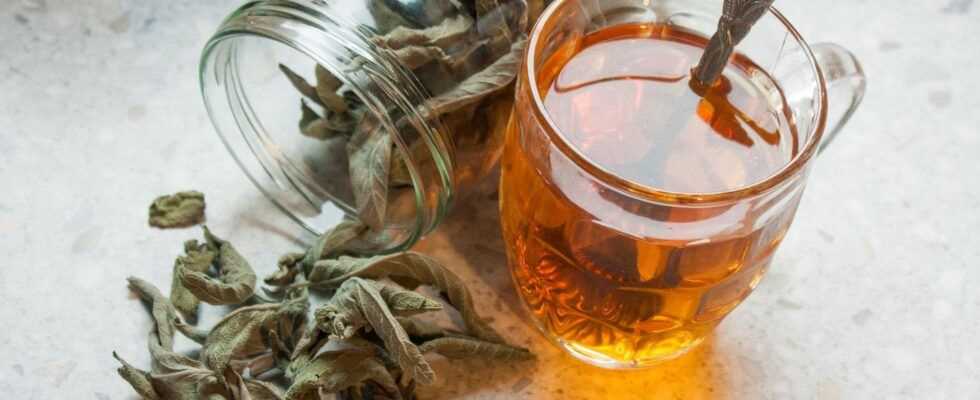Sage tea effect
What does the medicinal plant help against?
© SpelaG91 / Shutterstock
The use of sage as a medicinal plant helps in many cases. You can find out everything about the effects of sage tea and what side effects it can have here.
Effects of sage tea: important facts about sage
- Official name: Salvia officinalis (“Official Cure”)
- Family: Minted blood
- Flowering time: May to July
- Region: Mediterranean area
Sage: an overview of the medicinal plant
As a shrub, sage can grow up to half a meter in height. The sage leaves are quite narrow and are fresh or dried used as a spice. Sage leaves are also used in medicine, for example to help with inflammation.
Why is sage such a good medicinal herb?
Sage plants are used as medicinal plants because the sage leaves consist of essential oils and useful bitter substances such as flavonoids or diterpenescontain. Essential oils and bitter substances have a very positive effect on many ailments such as inflammation and diseases so that sage can be used both as tea and in the form of solutions or capsules.
Sage tea effect: how does the preparation work?
You can easily make sage tea yourself. Take about 1.5 grams of sage leaves (you can find dried sage leaves in health food stores or pharmacies, make sure they are organic) and pour 150 ml of boiling water over the leaves. Now you let the tea steep for about 10 minutes before you can enjoy it. Attention: You shouldn’t consume more than six grams of the leaves per day. If you want to use the tea against excessive sweating, for gargling or rinsing in the mouth, it is best to use 2.5 grams of leaves of the medicinal plants.
Effects of sage tea: 8 practical benefits
Sage tea can have these effects:
- The essential oils contained stimulate blood circulation and kill germs.
- Bitter substances help to loosen mucus and curb bleeding.
- Sage has an antibacterial effect and is therefore useful for colds and ailments such as coughs.
- As a home remedy for gingivitis, sage helps by reducing inflammation and relieving bleeding.
- Sage has a relaxing effect on digestive problems such as gas or bloating, as well as menstrual cramps.
- In general, sage helps reduce stress and tension.
- Memory can be improved with sage.
- Sage can inhibit sweat – if you sweat excessively, you should drink sage tea regularly.
Risks: Side Effects of Sage
Like all medicinal plants, the many advantages of sage are offset by side effects, which can occur above all in excessive doses or in unsuitable living conditions. You should keep this in mind:
- Small children, pregnant women and breastfeeding women should completely avoid sage. But: The plant is often used for weaning, as studies have found an inhibiting effect on milk production.
- The thujone contained in sage is a neurotoxin in high doses and can therefore cause headaches and gastrointestinal complaints if consumed over a long period of time.
- The side effects can also spread to the bladder and cause problems emptying it completely (urinary retention).
Sage usually has a very distinctive, slightly bitter taste. If you have a sensitive stomach, an increased dose, such as recommended against sweating, can cause nausea. In these cases, you can also rely on a ready-made herbal medicine from the pharmacy. These are available, for example, in the form of coated tablets. However, always study the package insert and ask the pharmacist specifically whether the herbal medicine is suitable for you.
The 9 best home remedies from around the world
9 pictures
Grow sage yourself
Sage originally comes from the Karst Mountains in the Balkans, but it was brought to Central Europe by monks centuries ago. You can easily grow it yourself as long as you take care to protect it in the cold winter. For example, you can plant sage in a pot on the balcony. In late summer the plant is cut back, in winter it is best to place the pot in a cool and sunny room.
If you want to use the sage for tea, it must be well dried. Harvest the plant between May and July, because then the young shoot tips are still particularly rich in essential oils. You shouldn’t wash the leaves, just wipe them off. So that the aroma of the medicinal plant is retained, it is best to dry it immediately after harvesting. Lay the sheets out on newspaper at 21 to 27 degrees in a well-ventilated room for about ten days. Then you can tie the stems together and hang them upside down. Extra tip: You can also freeze sage!
Sage isn’t the only plant that has anti-inflammatory properties. Would you prefer to drink a different tea? You can find out everything about the effects of green tea here. We will also show you whether exotic diets such as the military diet or the New York diet are good for your body and health.
sources
Mayer, JG et al .: Handbuch der Klosterheilkunde, Zabert Sandmann Verlag, 2006
Kraft, K. & Stange, R .: Textbook Naturopathic Treatment, Hippokrates Verlag, 2010
Bühring, U .: Medicinal Herbology – Basics – Therapy – Application, Haug Verlag, 2014
